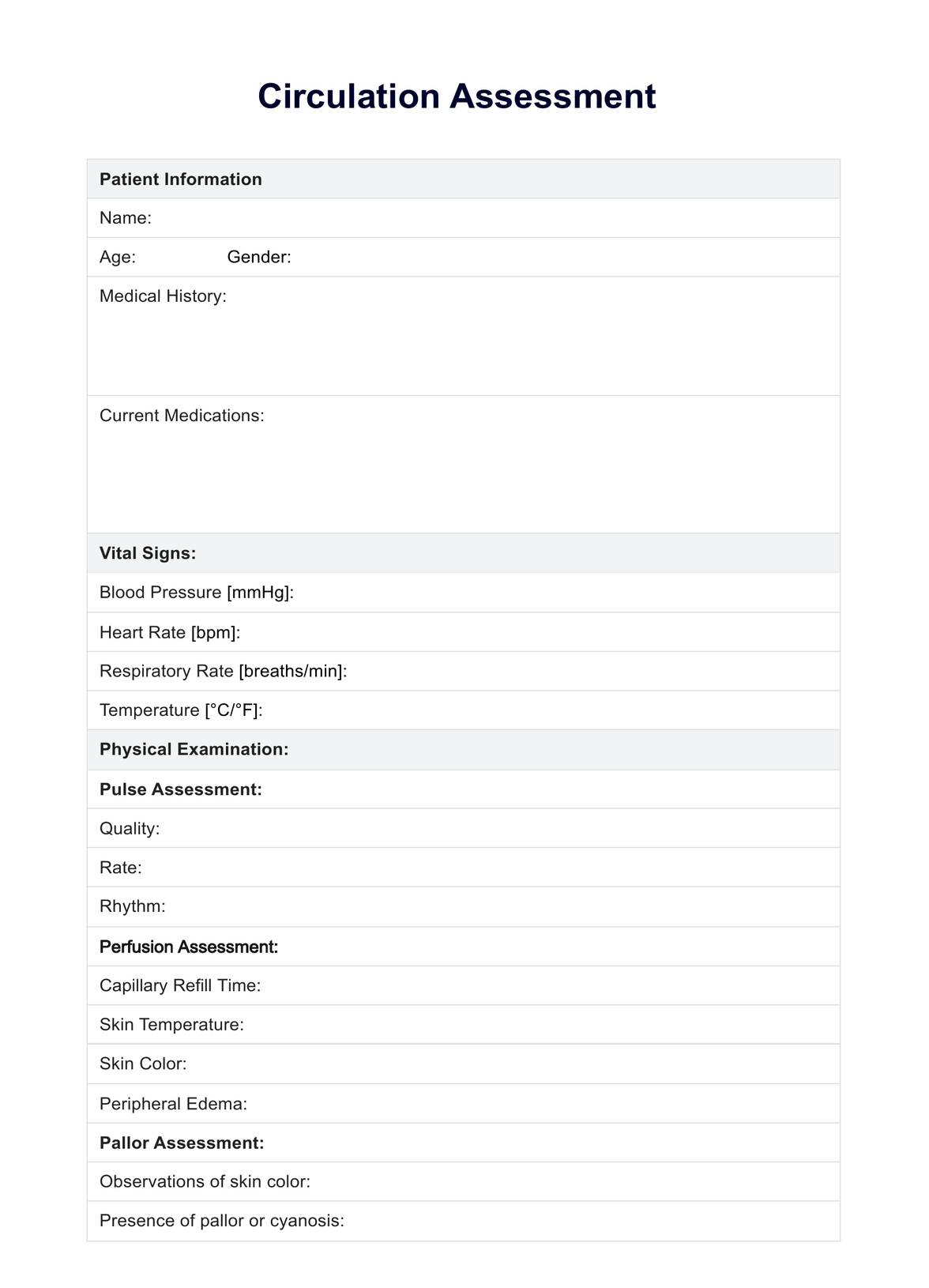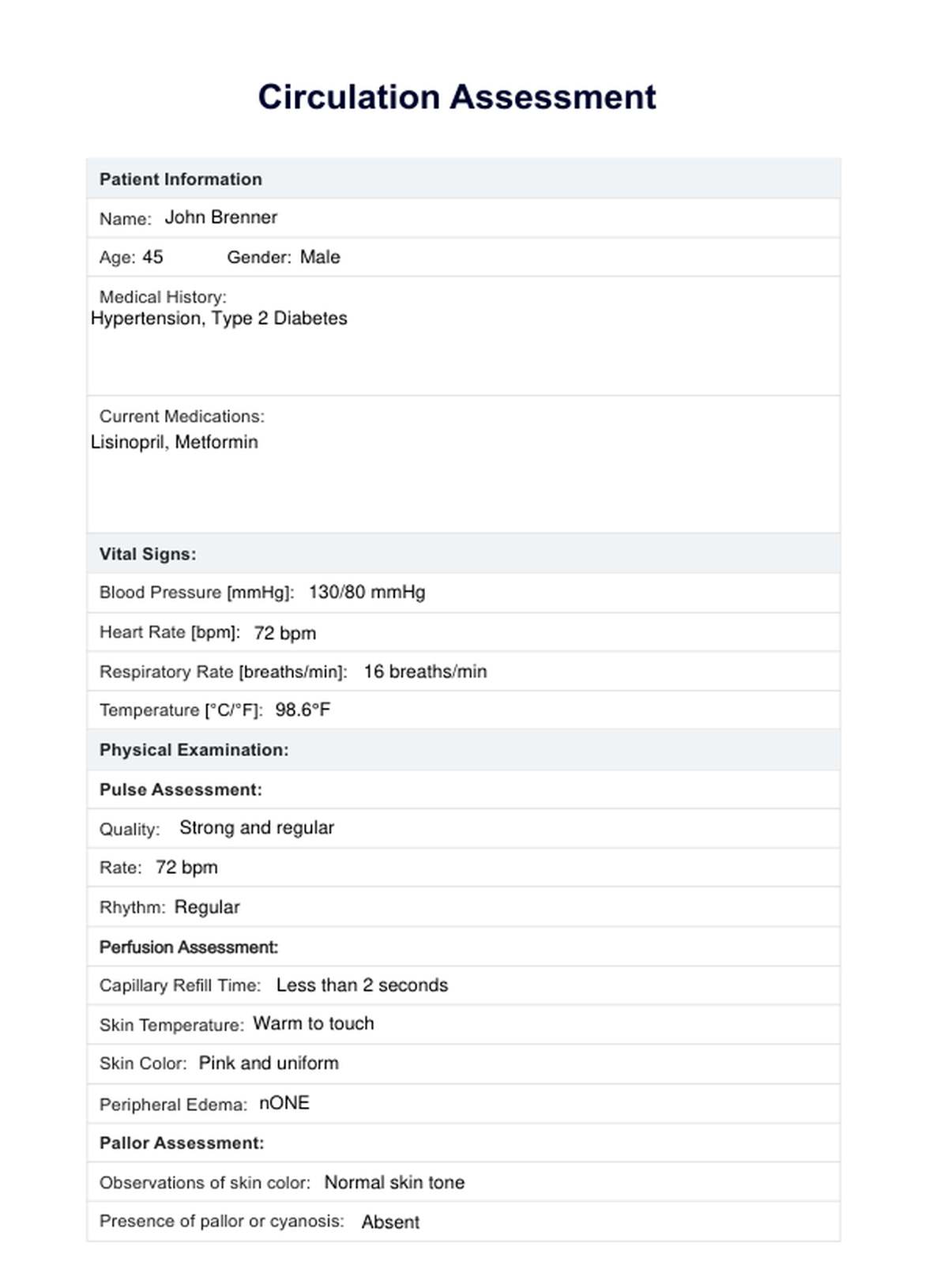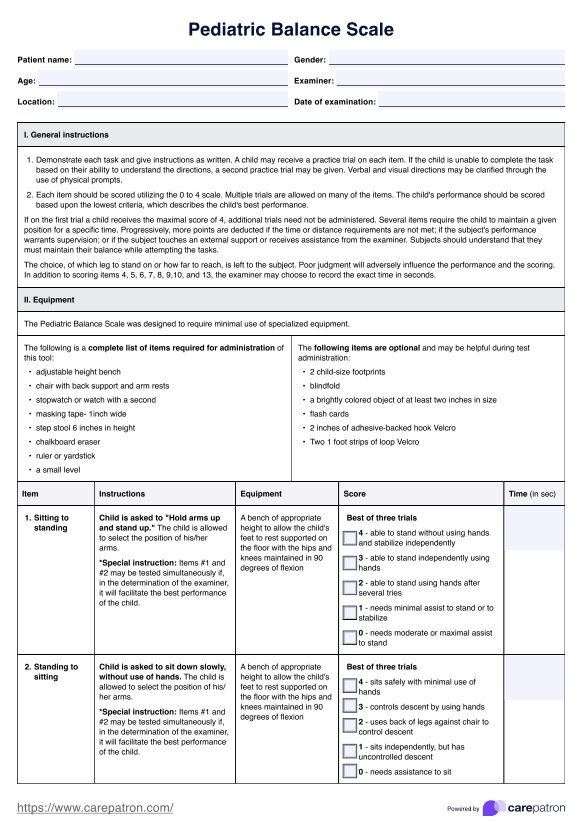Circulation Assessment
Learn about the circulatory system, its significance, and how to conduct a comprehensive Circulation Assessment using our free template example.


Understanding the circulatory system
The circulatory system, or cardiovascular system, is a vital network of organs and blood vessels that keeps you alive and functioning. It's like an intricate delivery system, constantly transporting oxygen, nutrients, and hormones throughout your body.
Here's a breakdown of the key players:
- Heart: The powerful pump at the center, with chambers that work together to send blood flowing in the right direction.
- Arteries: These vessels carry oxygen-rich blood away from the heart to nourish tissues and organs.
- Veins: They carry oxygen-depleted blood back to the heart for re-oxygenation.
- Capillaries: These microscopic vessels act as exchange points, allowing oxygen, nutrients, and waste to pass between the blood and surrounding tissues.
The circulatory system is constantly working to keep you healthy. However, reduced blood flow, blood clots (deep vein thrombosis), and peripheral vascular disease can disrupt efficiency.
Circulation Assessment Template
Circulation Assessment Example
Why good circulation is your body's best friend
Imagine your body as a bustling city. Every cell needs a constant supply of oxygen and nutrients to function, just like city residents need deliveries of food and resources. Good circulation is the efficient delivery system that keeps everything running smoothly. Here's how:
- Power up your cells: Oxygen is the fuel your cells crave to generate energy. Good circulation ensures a steady supply reaches every corner of your body, keeping you energized and functioning at your best.
- Waste disposal service: Just like a city needs to remove trash, your body must eliminate waste products. Good circulation acts as a garbage truck, carrying away carbon dioxide and other byproducts to keep your cells healthy.
- Optimal cellular health: Consistent blood flow nourishes your cells, keeping them working properly. It's like a constant flow of fresh groceries, ensuring your cells have everything they need to thrive.
- Keeping your cool (and warm): Circulation helps regulate your body temperature. It's like a built-in air conditioning and heating system, distributing heat and keeping your internal organs at optimal temperatures.
- Healing power: Good circulation is essential for wound healing when you get injured. It delivers immune cells and repair materials to the site, like sending a medical team to mend the city's infrastructure.
You invest in your body's health and well-being by maintaining good circulation.
What is a Circulation Assessment?
A circulation assessment is a checkup for your blood flow. Healthcare professionals use various methods to see how well blood travels throughout your body and identify potential problems. It's like a plumbing inspection for your internal network!
Here's what a circulation assessment typically involves:
- Vitals check: Blood pressure, heart rate, and breathing rate give clues about cardiovascular health.
- Body signs: Skin color, temperature, and texture are checked for abnormalities that might indicate circulation issues.
- Risk factor review: Your doctor will consider factors like high blood pressure, diabetes, smoking, and family history to assess your risk of circulatory problems.
- Pulse check: Feeling your pulse in your extremities (like wrists and ankles) helps assess blood flow strength.
- Heart sounds: Listening to your heartbeat with a stethoscope can reveal abnormal rhythms that might affect circulation.
By catching circulation problems early, healthcare professionals can take steps to treat blood pressure and prevent serious complications. It is preventative maintenance for your body's most crucial delivery system.
The 5 Ps of Circulation Assessments
Healthcare professionals use a handy tool called the 5 Ps to assess your circulation and identify potential problems. Think of it as a checklist for healthy blood flow!
- Pulse: This is the rhythm and strength of your heartbeat, felt at your wrist or ankle. A weak or irregular pulse might indicate a heart problem.
- Perfusion: This refers to how well oxygen-rich blood reaches your tissues. Doctors might check your skin temperature and capillary refill time (how long it takes for the color to return to your fingernail after pressing on it) to assess perfusion.
- Pain: Pain, especially in your legs or chest, can indicate reduced blood flow. Be sure to tell your doctor about any pain you're experiencing.
- Pallor: Pale or discolored skin, particularly on your face, lips, or nail beds, could indicate anemia or poor circulation.
- Paralysis: While this might sound scary, it's simply checking your muscle function and strength. Weakness or numbness could indicate circulation problems affecting your brain or spinal cord.
By using the 5 Ps, healthcare professionals can catch circulation issues early and take steps to keep your blood flowing smoothly.
How does our Circulation Assessment template work?
Our Circulation Assessment Template makes it easy for healthcare professionals to gather vital information and identify potential circulation issues efficiently. Here's how it works:
1. Patient snapshot
You can start by filling out the patient's basic information at the top of the template. This includes their name, age, gender, medical history, and medications.
2. Vital signs check
Next, accurately measure and record the patient's vital signs (blood pressure, heart rate, respiratory rate, and temperature) in the designated fields. Remember to follow established guidelines for accuracy and consistency.
3. Physical exam findings
Perform a comprehensive physical exam and document your conclusions under sections like pulse assessment, blood pressure readings, subjective cardiovascular assessment, perfusion assessment (skin temperature and capillary refill time), pallor (skin color), and paralysis assessment.
4. Risk factor review
Review the patient's medical and family history and health to assess their cardiovascular risk factors. This includes standard risk factors related to high blood pressure, diabetes, smoking, obesity, and a family history of heart disease. The template may also include additional risk factors to consider.
5. Summarize and recommend
Finally, summarize your findings from the physical exam, assess your medical history, and review the risk factors. Briefly document the physical examination, any abnormalities, relevant medical history, and identified risk factors. Based on this information, provide clear recommendations for further evaluation, treatment, patient education, and follow-up care.
When do healthcare professionals conduct this assessment?
Circulation assessments are like taking the pulse of your body's internal highway system. They help healthcare professionals evaluate vital signs and identify potential problems with blood flow throughout your body. Here's when you might encounter a circulation assessment:
- Yearly checkups: Think of them as routine maintenance checks. Just like your car needs regular tune-ups, your doctor uses circulation assessments during checkups to catch any early signs of issues.
- Surgery prep: Before surgery, a circulation assessment ensures your body's delivery system is functioning optimally, similar to how a mechanic checks your car before a long trip.
- Post-surgery monitoring: After surgery, your doctor will monitor your circulation to identify potential complications, just like ensuring your car runs smoothly after repairs.
- Unexplained symptoms: If you experience symptoms like chest pain, numbness, or weakness, a circulation assessment helps your doctor pinpoint the cause.
- Managing risk factors: If you have high blood pressure, diabetes, or other risk factors for poor circulation, regular assessments help your doctor manage your heart health and prevent problems.
By regularly monitoring your circulation, healthcare professionals can take proactive steps to keep your blood flowing smoothly and maintain your overall health.
Benefits of conducting this assessment
A comprehensive circulation assessment offers significant advantages for both patients and healthcare professionals. These assessments go beyond simply checking your pulse; they provide a detailed picture of your circulatory health, allowing for early detection of problems, improved patient safety, and personalized care plans.
Here's a closer look at the key benefits:
Early detection and intervention
One of the key benefits of conducting a circulation assessment is the ability to identify potential problems early on. These assessments can uncover abnormalities like turbulent blood flow or unusual findings during the physical exam before cardiac surgeries. By catching issues early, healthcare professionals can intervene before they become more serious, potentially preventing complications and improving long-term health outcomes.
Enhanced patient safety
Regular circulation assessments are vital in enhancing patient safety. By evaluating the patient's cardiovascular system and checking for symptoms that might suggest circulatory problems; healthcare professionals can identify individuals at higher risk of cardiovascular events. This allows for closer monitoring, preventative measures, and potentially life-saving interventions.
Personalized care and better outcomes
Circulation assessments provide valuable insights into a patient's cardiovascular health. By maintaining cardiovascular evaluation and understanding the patient's medical history, current symptoms, and assessment findings, healthcare professionals can create personalized treatment plans and educational resources. This tailored approach ensures patients receive care that directly addresses their individual needs and helps them achieve optimal health outcomes.
Commonly asked questions
Common cardiac risk factors include hypertension, diabetes, high cholesterol levels, smoking, obesity, sedentary lifestyle, family history of heart disease, and age.
Hypertension can affect circulation by causing the heart to work harder to pump blood throughout the body. This increased blood pressure also can damage blood vessels, narrowing and reducing blood flow to organs and tissues.
Signs and symptoms of PAD include leg pain or cramping during activity (claudication), numbness or weakness in the legs, coldness in the lower leg or foot, sores or ulcers on the legs or feet that won't heal, and changes in the color or texture of the skin on the legs or feet.
















































































































